Cambodia is an Indochina destination not to be missed. Full of beautiful temples, historical significance, kind people and delicious food, Cambodia left me wishing I had more time there. Even with a short stay though, you can get a great flavor of the country. I would recommend pairing this trip with neighboring destinations such as Vietnam, Thailand and Laos. At minimum, ensure your itinerary includes Siem Reap and specifically, the Angkor area which is a UNESCO world heritage site.
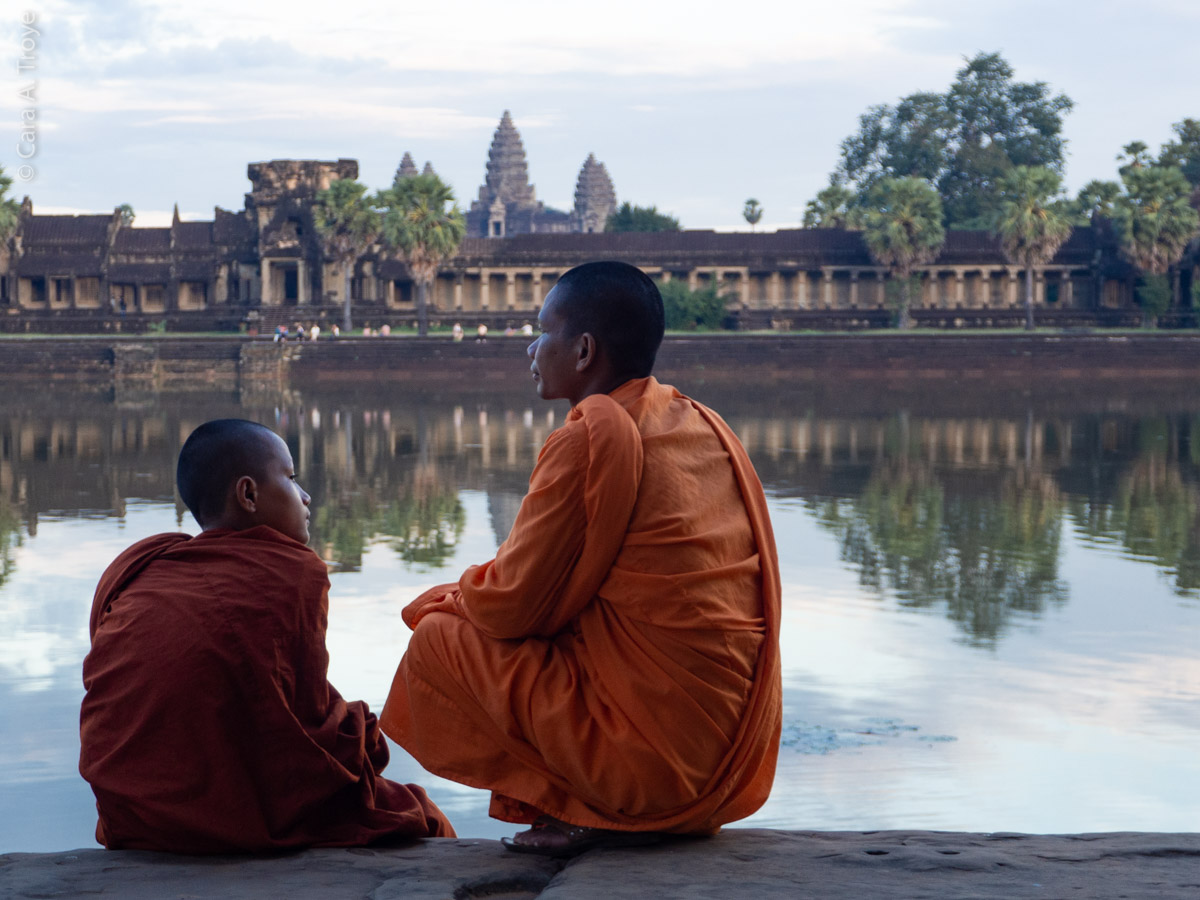
Angkor Wat Monks
Angkor Wat
This is the largest religious monument in the world and a photographer’s dream. Visit at sunrise and sunset for very different photo opportunities. The key is navigating the crowds. It is impossible to avoid the masses of tourists, but there are some strategies that can help. The gates open at 5am, so if you get here early and wear comfortable shoes, once through the gate, jog across the causeway to the pool on the left of the complex to set up a tripod at the very edge of the water toward the center left of the pool – this is the prime location to capture reflexions in the water and ensures you have no one blocking your view. Then, just wait for the sun to rise. There will be a good amount of time to capture sunrise before the floods of tourists decide to walk around the pond and impact your view because the temple itself is not open this early in the morning.
Consider returning in the afternoon to set up your tripod for sunset too. Weather will impact colors and visibility. The temple itself was originally constructed in the 12th century for the Hindu god Vishnu but evolved into a Buddhist temple. The inner gallery is reached by steep stairs and only a predetermined number of individuals are allowed to enter at one time. As groups of tourists descend and exit, more are allowed to make the climb. There are great views of the grounds from the top as well as some beautiful Buddhist statues. You may spot monkeys near the perimeter walls – they are not aggressive but fast moving on the ground, usually foraging for food.
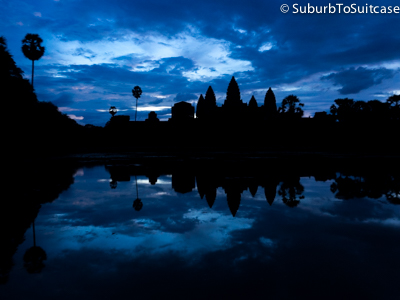
Angkor Wat at Dawn
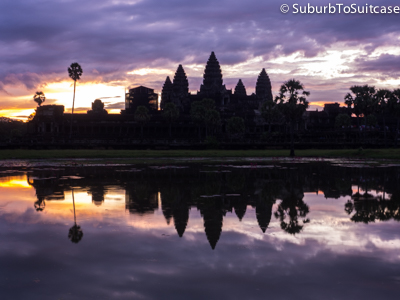
Angkor Wat Light Progression
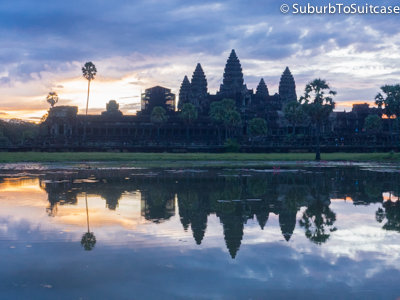
Angkor Wat Sunrise
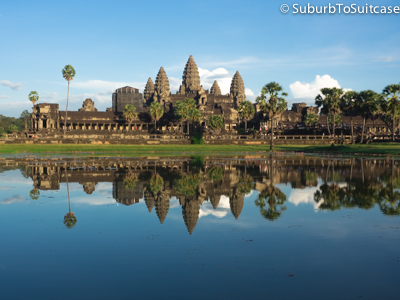
Angkor Wat Before Sunset

Angkor Wat Stairway
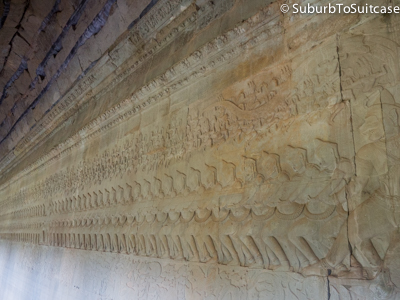
Angkor Wat Elaborate Carvings
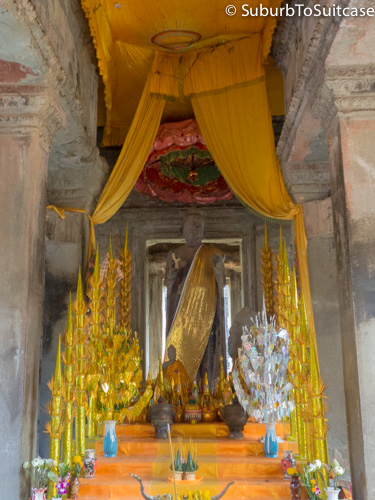
Statues Inside Angkor Wat Temple Tower
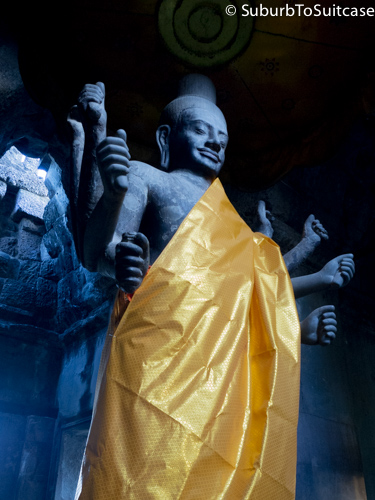
Statue Inside Angkor Way Temple Tower
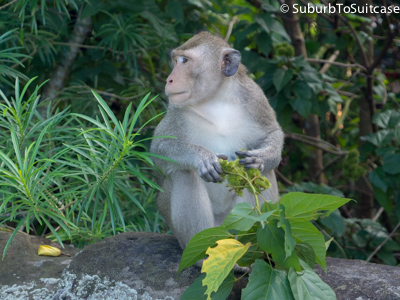
Monkey Posing at Angkor Wat
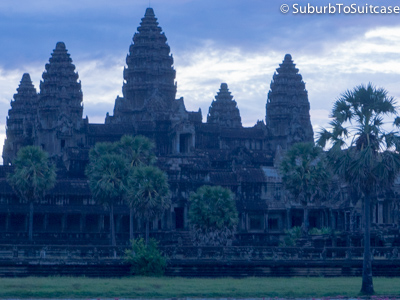
Sunset at Angkor Wat Temple
Angkor Thom
This is not a temple, but rather, a city within a city, constructed in the late 12th century. It is best to enter from the spectacular South gate bridge which is lined with stone statues carrying the naga serpent. A keen eye will notice that some of the statues are original and some are more recent. Many of the original pieces have been stolen over the years and replaced with replicas (a common theme in Siem Reap). Inside the complex are several temples and monuments (Bayon Temple, Baphoun, Elephant Terrace, Leper King Terrace, etc.) and each is just a short walk away. Bayon Temple, specifically, is absolutely breathtaking. There are more than 200 stone face carvings of varying size within Bayon and there are different viewing angles to see some that might otherwise go unnoticed. In the Angkor temples, there are often series of three or seven items (statues, pillars, stones, towers, etc.) and each count has its significance. Patterns of three, for example, often represent the gods Śiva (the destroyer), Vishnu (the preserver) and Brahma (the creator). This is where a tour guide really comes in handy.
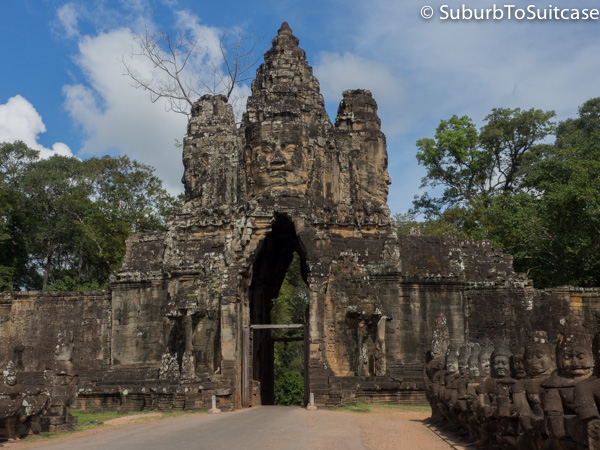
South Gate Entrance to Angkor Thom
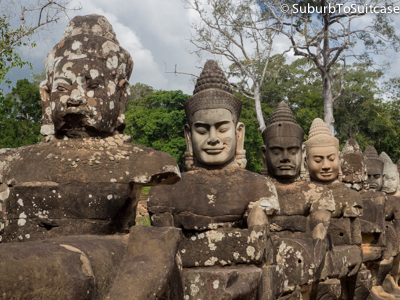
Faces at South Gate Angkor Thom
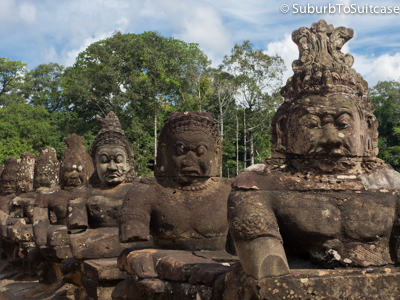
Faces at South Gate Angkor Thom
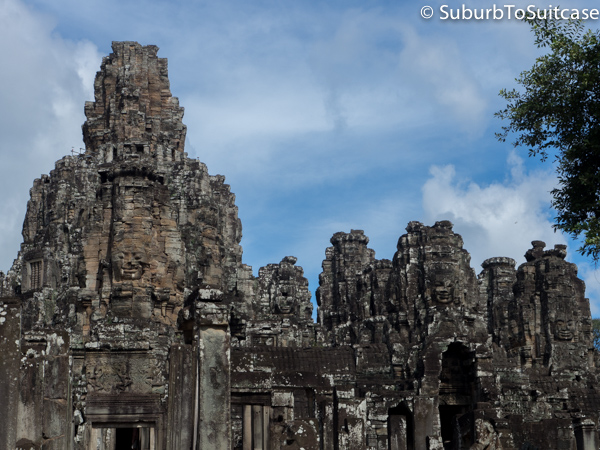
Bayon Temple and it’s many faces
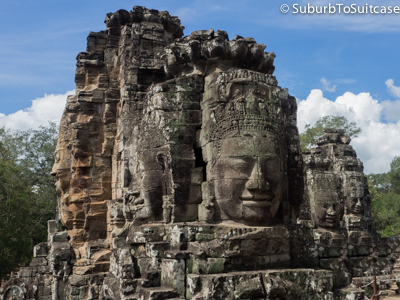
Bayon Temple Stone Faces
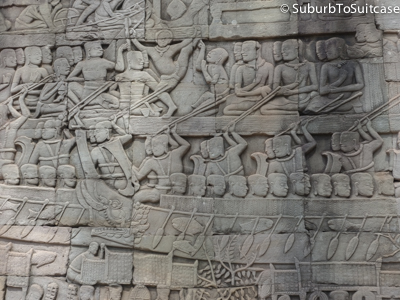
Intricate carvings at Bayon Temple
Ta Prohm
This temple was abandoned in the 15th century after the fall of the Khmer Empire and the uniqueness of this site lies in the jungle surroundings that have taken over the temple. Sadly, this is now commonly referred to as the “Tomb Raider temple” rather than the given name because this is where parts of the movie were filmed. Tree roots have wrapped around the blocks to create a distinctive appearance. The faces carved into the stone are a bit more hidden now due to decay and tree roots. The size and scale of the trees is difficult to photograph but they are massive. There are carvings on the stone throughout the temple as well. One image appears to be a dinosaur leading Cambodians to believe these creatures could once have coexisted with humans here. See photo below – it does resemble a stegosaurus.
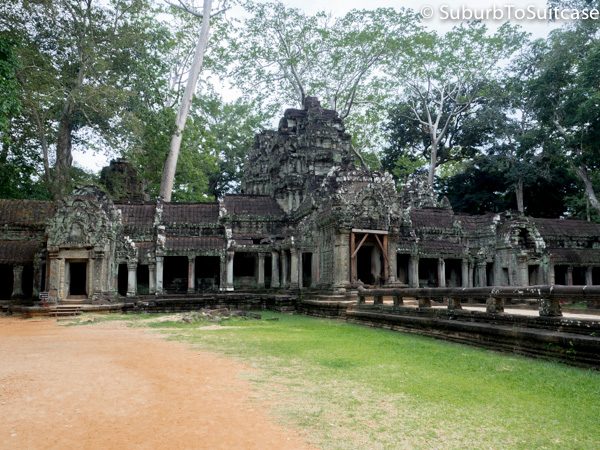
Ta Prohm Exterior

Ta Prohm – Can you see the hidden face?
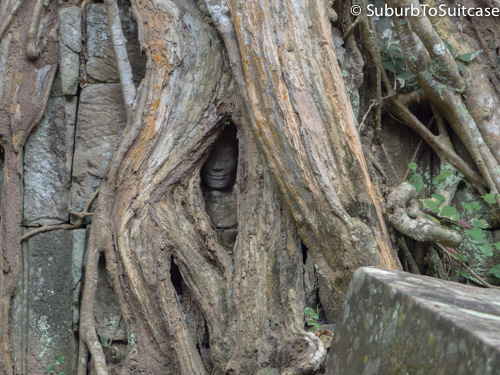
Ta Prohm – Another hidden face
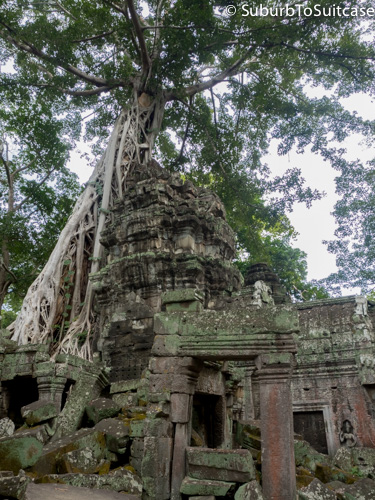
Ta Prohm Tree Roots
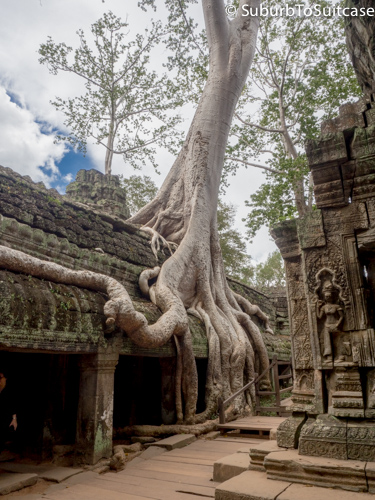
Ta Prohm Tree Roots
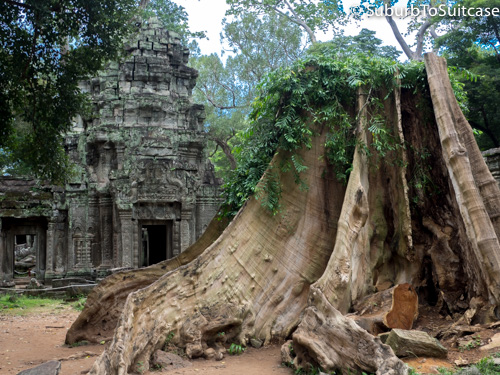
Ta Prohm with tree trunk in front for scale
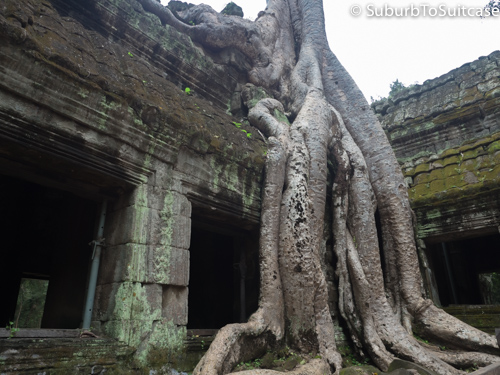
Ta Prohm giant roots cascading over temple
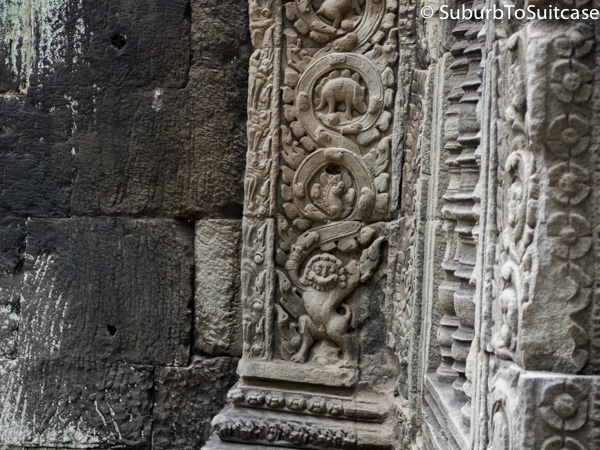
Ta Prohm carvings – Do you see a dinosaur?
Phnom Bakeng
Constructed as a mountain temple in the 9th century, there is a hillside climb required to arrive at the base. The hike is manageable but the heat can make this more draining than usual. Once at the base, you still have to climb a very steep set of stairs to the top of the overlook but there are handrails. I read about people viewing the sunset here but in my opinion, the climb down (stairs and hill) in the dark would not be fun and there are better places like Angkor Wat to watch a sunset. This site is under renovation also. Each brick that has been removed is labeled for proper reinstallation. There are piles of numbered blocks around the perimeter. Unfortunately, much of the original carvings at the top were subject to theft so there are only a couple of faces still intact.
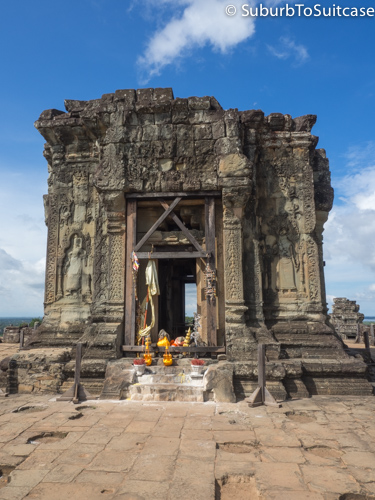
Monument on Phnom Bakeng
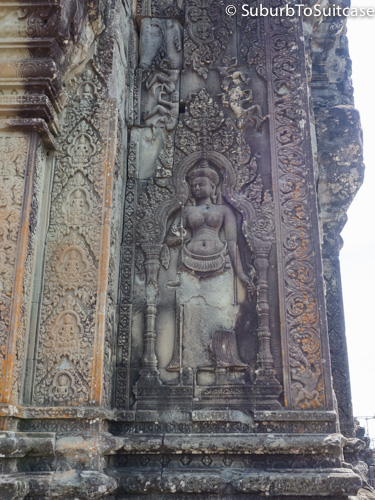
One of the last fully intact carvings at Phnom Bakeng
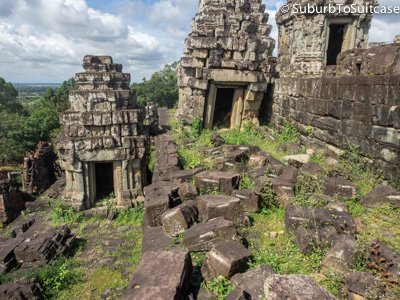
Phnom Bakeng Restoration in Process
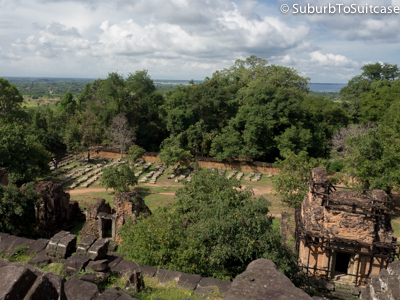
Phnom Bakeng Restoration in Process
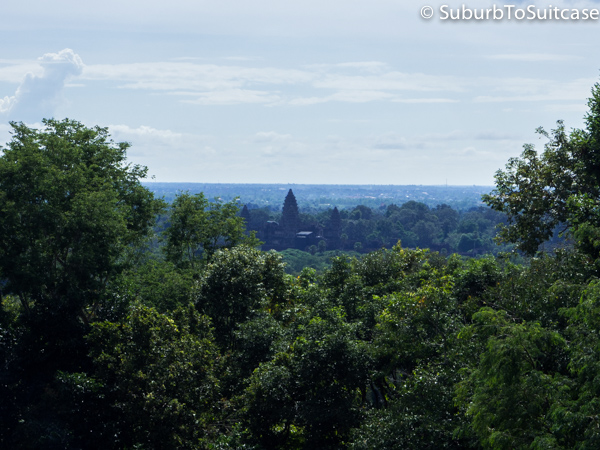
View of Angkor Wat in the distance from Phnom Bakeng
Baksei Chamkrong
This 10th century site is near the South gate of Angkor Thom and was the first temple-mountain in Cambodia built with brick. Its name means “The Bird Who Shelters Under Its Wings.” There are four sets of very steep stairs to tower at the top with the North stairway being better for climbing. You can carefully make the 15 meter climb to the sanctuary and find the reclining Śiva statue inside with offerings from the local people (incense, fruit, etc.). When we climbed, there were no other tourists so my guess is that this is either a very quiet temple with everyone else inside Angkor Thom or visitors other than locals are too nervous to climb the old stairs.
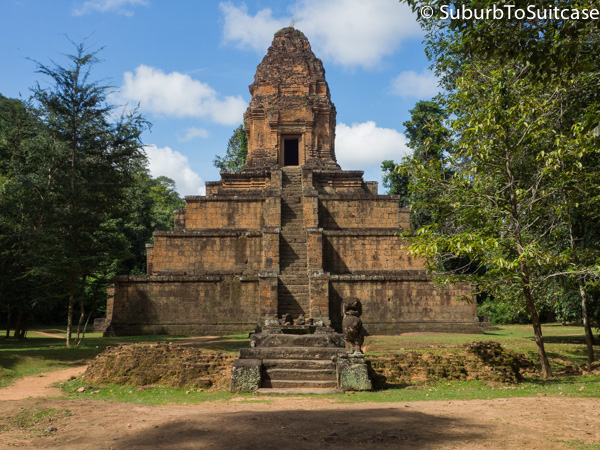
Baksei Chamkrong

Inside Baksei Chamkrong Tower
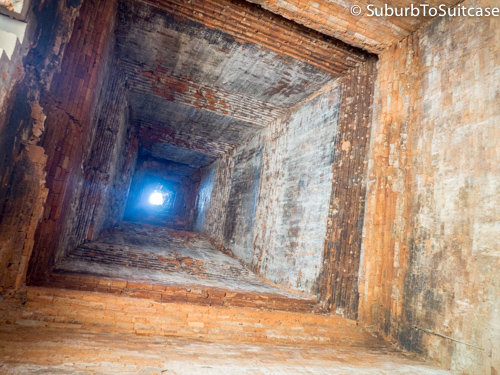
Baksei Chamkrong View Through Top of Tower
Ta Nei
This rural temple is tucked away from the main road and requires a drive through deep jungle to arrive. Constructed in the late 12th century, many of the boulders have fallen over the years so you have to choose your entrance carefully if you do not want to climb over ruins. Because this is more remote, there are few visitors – the area is peaceful and only minimally preserved, creating an unique experience.
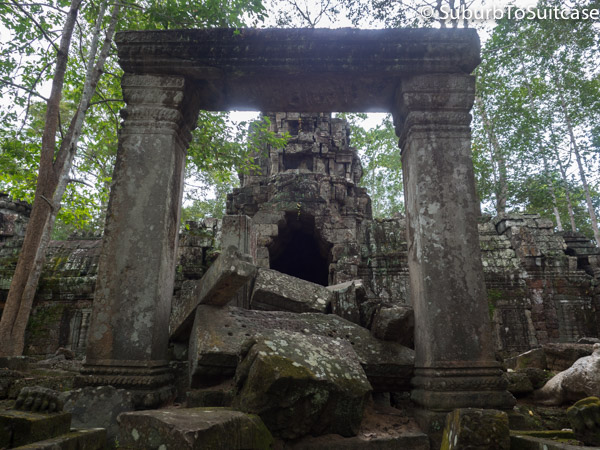
Ta Nei Jungle Temple
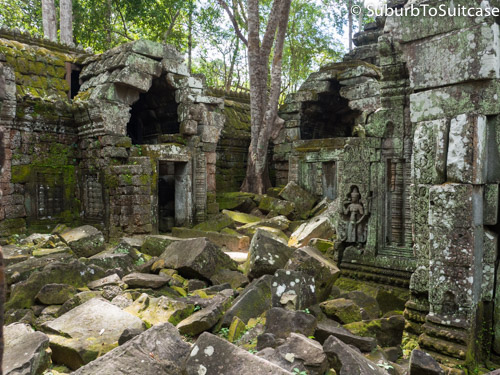
Ta Nei Ruins
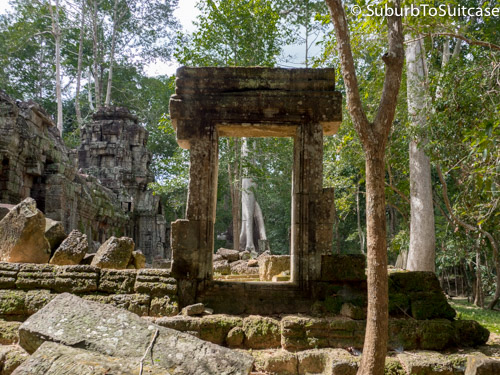
Ta Nei Doorway
Banteay Srei
This temple (commonly referred to as B-Srei or the citadel of women) was constructed in the 10th century and is located about 40 minutes via tuk-tuk from the Angkor archaeological site. The road to B-Srei can be dusty so consider sunglasses and a scarf if you are riding an unenclosed vehicle. Combining this with B-Samré makes a nice afternoon and no tour guide is really necessary. There is good signage at the entrance so you can read about the history. The distinctive pink/red sandstone gives this monument a different appearance than many of the other temples. The carvings are intricate and well preserved. Because this is removed from town, there are far fewer visitors.
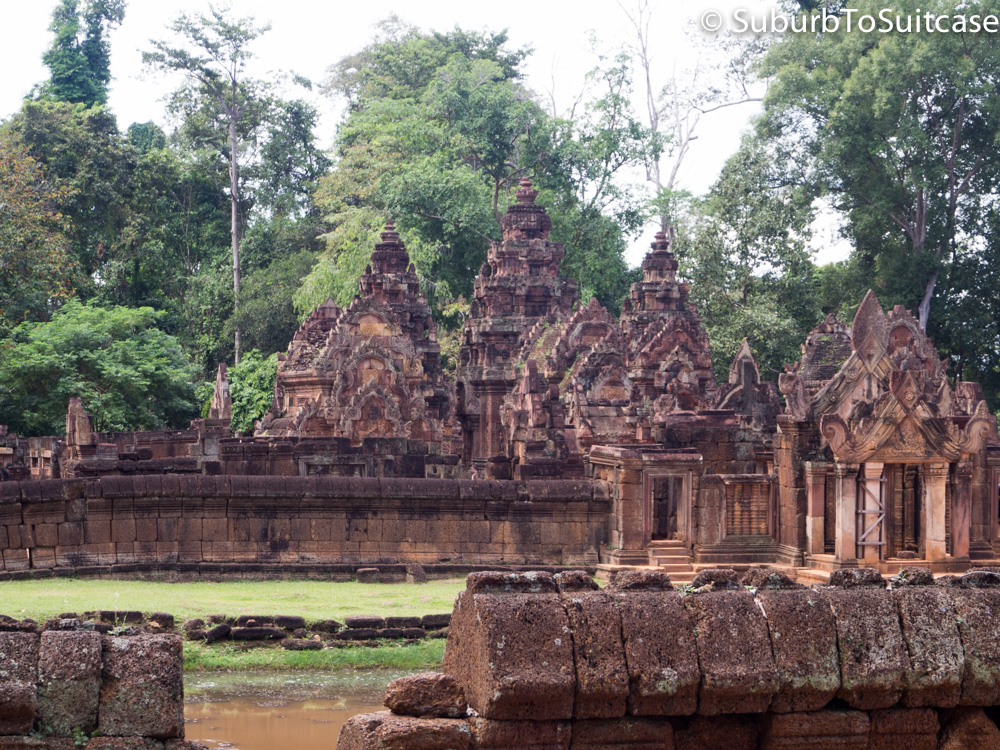
Banteay Srei Temple
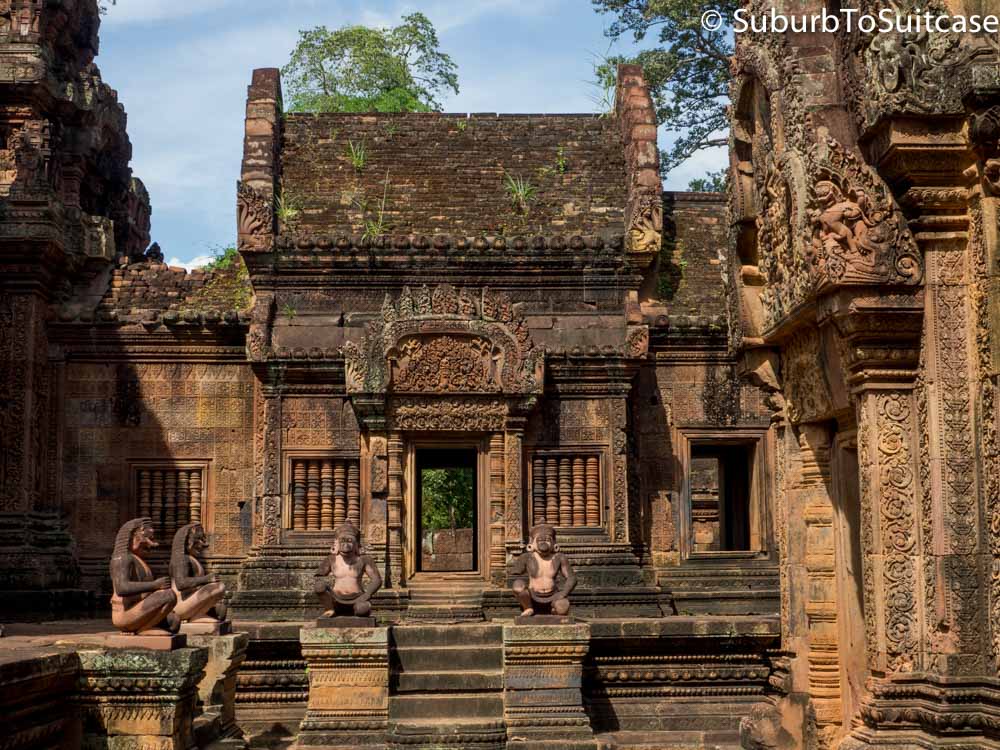
Banteay Srei Temple
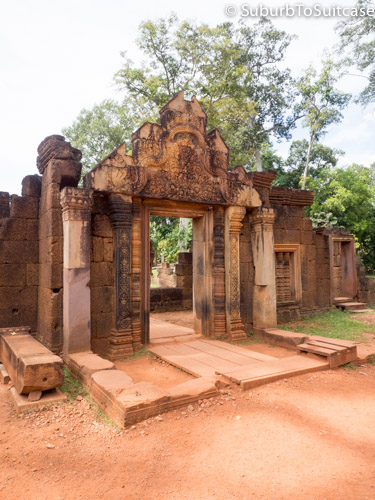
Banteay Srei Doorway
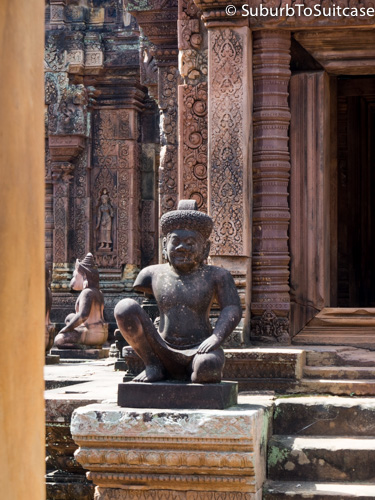
Banteay Srei Statue
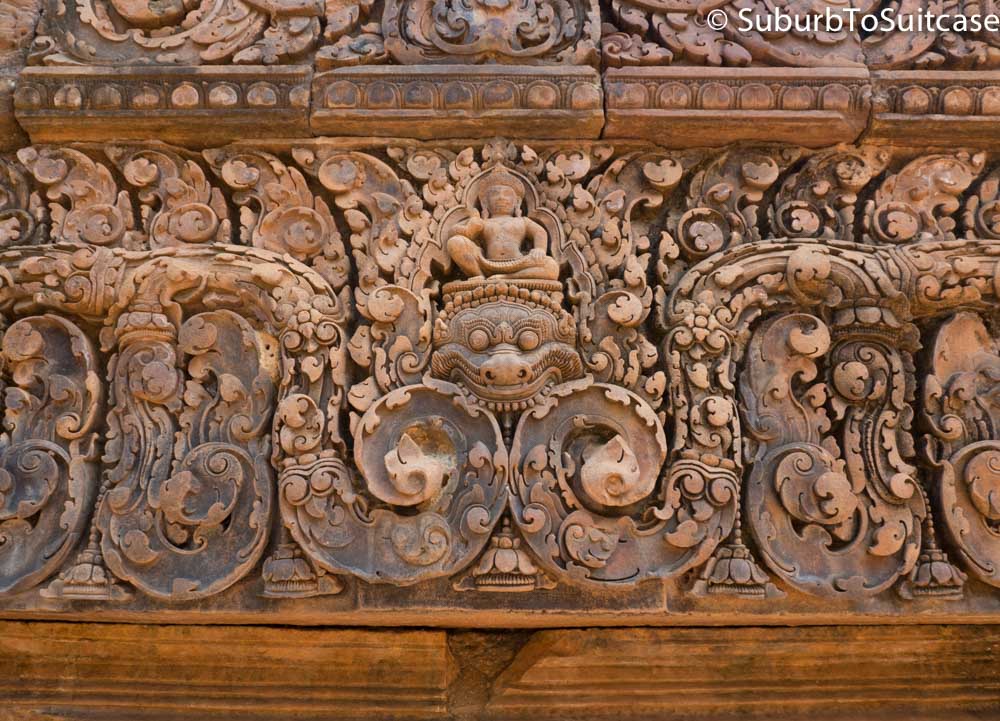
Banteay Srei Details
Banteay Samré
Built in the 12th century, this monument is less visited probably due to its less elaborate style. If you are already at B-Srei though, you can stop since it is on the way back to town. The notable feature here is the inner moat (most other temples had outer moats). Otherwise, there is not much to see other than numerous, similar shaped stone window spires and a statue that has been stolen except the feet. When we arrived, we spotted a cat and also a cow grazing at the exit but otherwise, desolate.
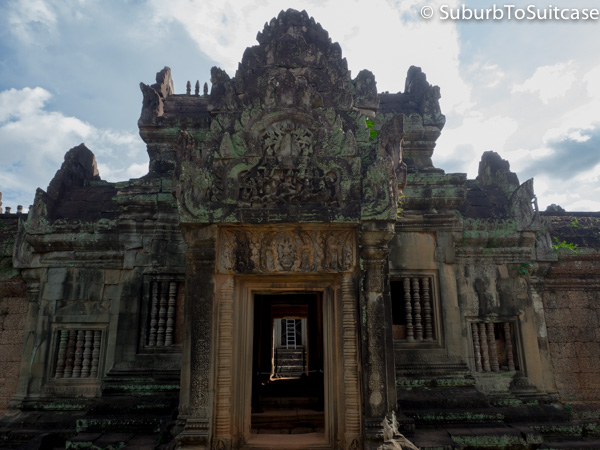
Banteay Samré Facade
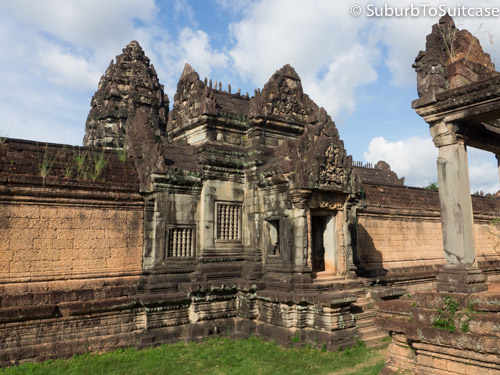
Banteay Samré – Inner moat separates the complex
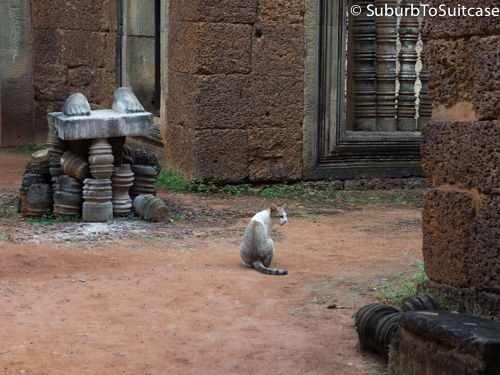
Banteay Samré – Desolate and Drab
Recommendations:
- Try the Khmer food! My favorite dish was definitely fish amok (also available as chicken amok) and while there is general similarity to the recipe of steamed coconut curry fish, each preparer can make this slightly differently. The presentation can also vary from being served in banana leaves to a hollow coconut. Fragrant flavors of lemongrass, turmeric and galangal are potent and so delicious.

Fish Amok in Coconut
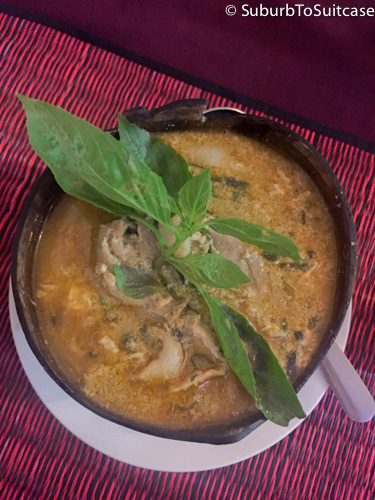
Another version of Fish Amok
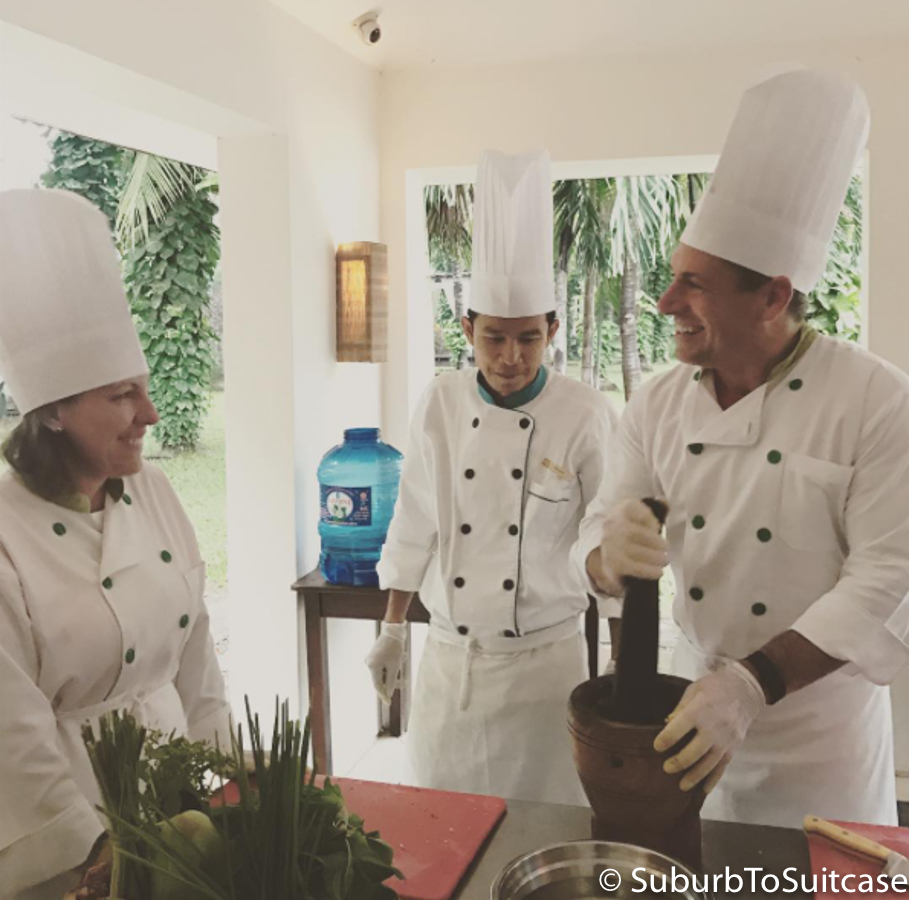
John and I took a cooking class since we loved Khmer food so much.
- Visit the night market. This is where you can purchase souvenirs such as a traditional krama scarf. This is definitely a tourist area so bring your bartering skills but know a vendor will not sell below a price point where they are comfortable. Generally speaking, everything in Cambodia is inexpensive so you can easily find something for any budget. Stalls line a number of streets but you can find everything from textiles to massages, fish pedicures and skewers of scorpions are for sale in this area.
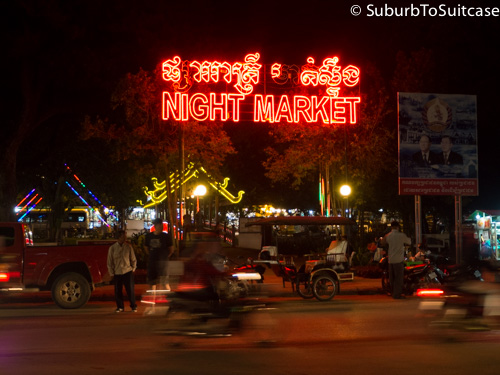
Siem Reap Night Market
- If you tire of traditional food (I’m not sure how this is possible) or are just looking for nightlife, then the Pub Street area is very popular for tourists. This area is right next to the night market and seemed safe enough, but the area is congested and requires a taxi or tuk-tuk to get there since outside of these streets, there are far fewer people, especially on foot.
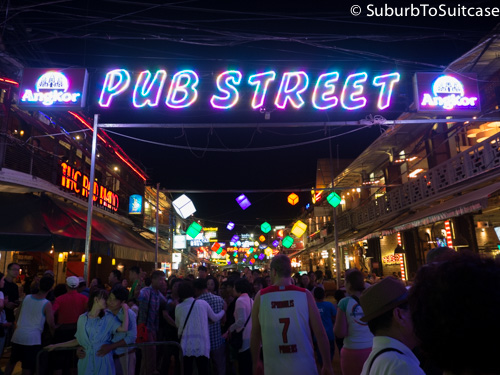
Expect plenty of congestion and adult beverages at Pub Street
- Try a more local experience and stroll through the daily fresh market. Household items and dry goods such as spices line the perimeter along with dried meats and dried fish (a staple). The interior aisles include fresh herbs, vegetables and fruits as well as fresh meats. Expect to see vendors plucking chickens, scaling fish and preparing frogs for sale. The whole experience is quite a sight and very busy since most locals prepare fresh meals daily.
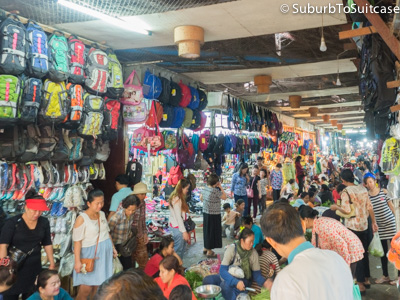
Local Fresh Market
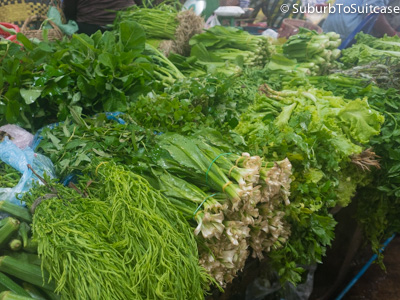
Herbs and vegetables at the fresh market
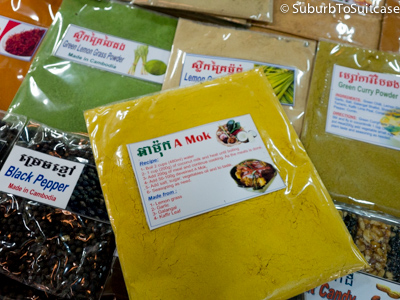
Spices and mixes at the fresh market
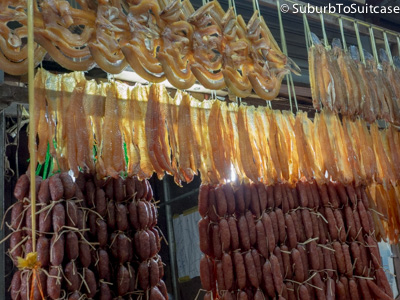
Dried fish and meats at the fresh market
Travel Tips:
- Research Cambodian customs in advance to better understand cultural norms (including bowing and common words) and etiquette. If you are planning to visit temples, most all require knee and shoulder modesty so plan ahead. Appropriate coverage for both men and women includes t-shirt length sleeves on top and capri or full length pants on bottom. In general, it is very rare to see anyone in Cambodia wearing shorts or tank tops since this is a very modest region.
- Consider weather in your travel plans. It can be difficult to find a perfect time to visit because cooler weather if often linked to rain. The rest of the time, the heat can be oppressive. During my stay, the temperature was 96-100°F with 100% humidity. With the heat index, it is important to stay hydrated to avoid heat exhaustion. Steep climbs to points of interest were more challenging in the middle of the day, but this was also the best time to avoid crowds so it really is a balance.
- Pack comfortable and sturdy shoes. The temple sites involve a variety of terrain from red dirt to uneven stone paths to climbing over boulders, depending when and where you go. A number of monument entrances require climbing up narrow, steep stone step without railings so having stable footwear is smart.
- Consider packing electrical outlet adapters and a travel power strip. Many hotels have outlets similar to the US, but not all. Cambodia generally uses type A, C and G plugs.
- American dollars are widely accepted in Cambodia as well as Visa credit cards so there is no pressing need to exchange currency if you are in well populated areas.
- Carry a small daypack with camera, travel flashlight, travel tripod, water, hand wipes, tissues, etc. Again, heat can be overwhelming so plan ahead. Consider packing a snack like a granola bar since once you are out and about, you may not want to return to your accommodations until you are done with your trek.
- If you are staying a few days in Siem Reap, you can purchase a three-day temple pass for $40 USD (daily pass is $20 USD). This is helpful if you plan to return to Angkor Wat for sunset on a different day, for example. Keep in mind also that it is possible to become “templed out” by seeing too many sites in one day. Having access across multiple days can help manage your time and also the intensity of the heat. The key is to hold onto the pass and bring it everywhere. Many of the smaller, farther temples require the pass for entrance so you will end up showing this often. If you purchase the pass during off-peak hours, there are no lines and the process including photo is very quick.
- As with any travel, be aware of your surroundings and apply general sensibility with your camera, gear and money to discourage petty theft and pickpocketing. Do not carry your passport when touring unless there is a specific reason you need it.
- Consider hiring a guide for at least one day of temple touring because there is so much history and each area has its special intricacies that would easily be missed without the help of a local. The highest rated guides (easy to find) also know the patterns of the huge tour group operators and can work your itinerary so that you arrive just before those crowds. This is a major benefit for photographers to have some time with fewer tourists around. Tour guide prices are reasonable and well worth it. Otherwise, you can hire a tuk-tuk driver to take you most anywhere on your own. There is often an up-charge for English speaking drivers but you should not expect to find proficiency unless hiring from a hotel.
- If you hire a tuk-tuk and want the person to return to pick you up, be sure you know exactly where to meet. Know the side of the street, the color of the tuk-tuk, any notable markings on the vehicle, and the name that appears on the side. At night, especially, tuk-tuks look very similar and due to congestion, it can be difficult to locate yours in an unfamiliar area.

Typical tuk-tuk attached to a moto
- Keep an eye out for spirit houses. Most Cambodians place these shrines atop pillars near their homes and at businesses. The shrines, said to originate from animism, create shelter for spirits and offerings are intended to appease the spirits. Each is unique, often colorful, and might contain items such as flowers, fruits, photos and incense.
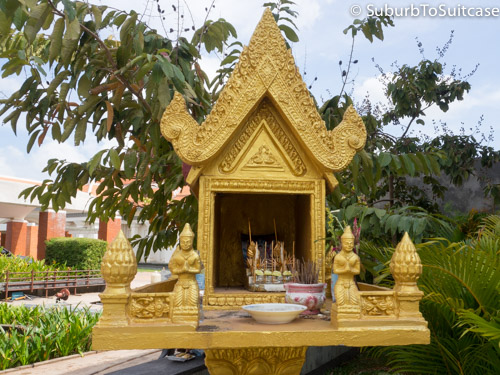
Spirit houses range from simple to quite elaborate
- Lastly, watch for elephants. Some shared paths are marked to remind you that you may encounter animals along your treks.
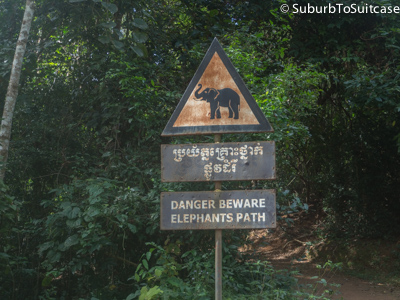
Watch for elephants at Phnom Bakeng
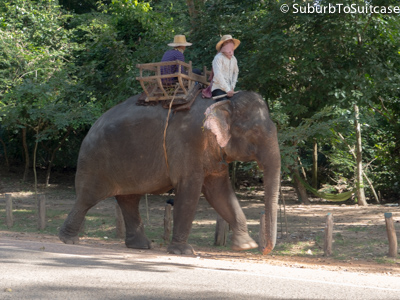
Elephant Near Angkor Thom
